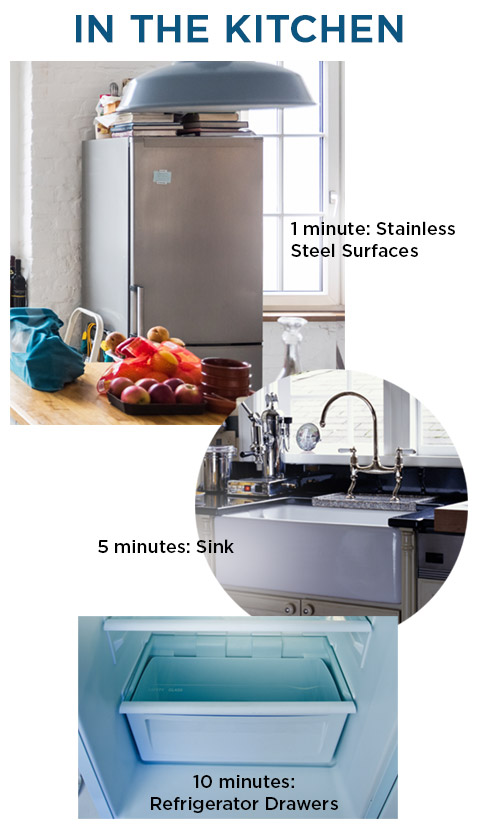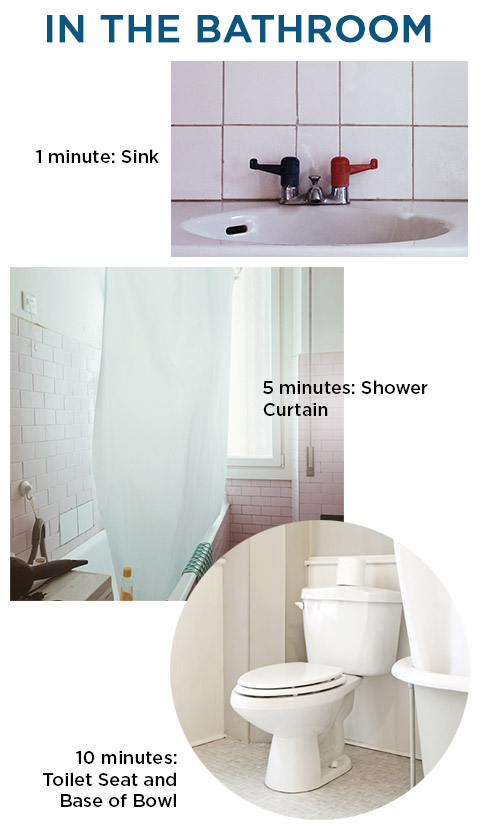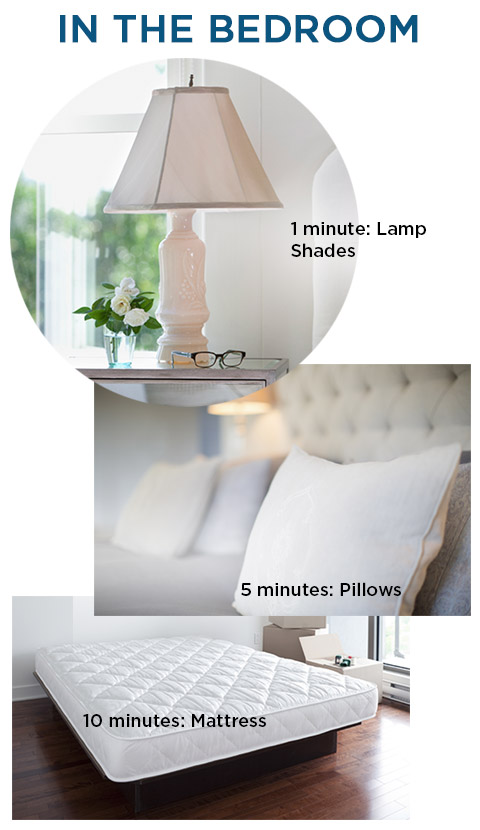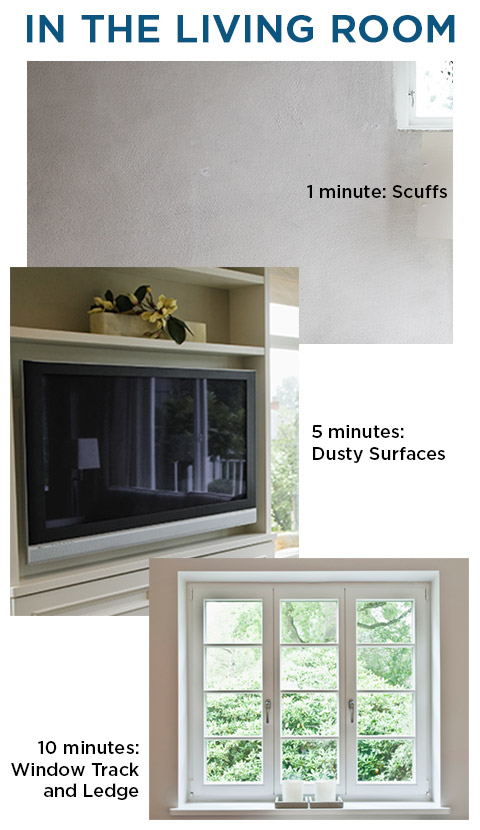How to Clean (Almost) Everything in Minutes
Shortcuts to deep-clean the filthiest part of your home.

Photo: heshphoto/Getty Images
Got one, five or 10 minutes? Experts reveal the deep-cleaning solutions that every renter—hello, full security deposit!—and homeowner should know.

The secret to cleaning the surfaces of stainless steel appliances—magnets for fingerprints, dust and watermarks—lies in the rind of your favorite fruit, says Donna Smallin Kuper, a cleaning expert with more than a decade of experience and author of Clear the Clutter, Find Happiness. A quarter-sized drop of pure citrus oil on a microfiber cloth will eliminate spots and leave behind a bit of residual oil that repels stains. If you don't have citrus oil, baby oil is a good alternative. Wipe in the direction of the grain (usually up and down on refrigerators).
Surprisingly, the place where you wash dishes nightly is dirtier than you'd believe. In a 2011 NSF International study, there was evidence of coliform bacteria—a group that includes foodborne-illness causing salmonella and E. coli—in 45 percent of kitchen sinks swabbed. Use an old toothbrush or bottle brush (with dish detergent) to remove the gunk from around the faucet, where the sink meets the countertop, and the drain. "Disinfectant is only effective on a clean surface," Kuper says. "The only type of sink that bleach is safe to use in is a solid surface sink," Kuper says. A safer option for stainless steel sinks is commercial disinfectant. Once the surfaces are clean, spray and let it sit for a few minutes (follow instructions on the label) before wiping the sink dry. If using bleach, Kuper recommends using one part bleach to 16 parts water. The CDC recommends letting the chlorine bleach disinfectant stand for three to five minutes and rinsing with clean water. Bleach should never be mixed with ammonia or any other cleaner. If using indoors, keep windows or doors open for ventilation. "Another option is using a small steamer—such as the Brio 500CC Steam cleaner—to disinfect without chemicals," Kuper says.
The best time to clean your refrigerator is when it's partially empty—ideally, the day before your scheduled grocery trip. "Toss out anything that's expired. Using a regular all-purpose cleaning spray on a rag (don't spray in refrigerator), wipe one side, then move items over to the other side and wipe the bottoms of the bottles," Kuper says. Then hit the refrigerator crisper and drawers with mild detergent mixed with warm water. For any caked-on spills, take a stack of wet paper towels lay them on top of the stain and let it soften the gunk while you attack the other areas.

With 60 seconds to quick clean, Becky Rapinchuk, Clean Mama blogger and author of The Organically Clean Home book, would wipe down her sink because it's one of the first things you notice in a bathroom—especially if there are water marks or toothpaste gunk. If you have more time to spare, you might whip up her DIY chemical-free disinfecting spray: 1/2 cup white vinegar, 1/2 cup vodka (for germ-killing properties), 10 drops lavender essential oil, 10 drops lemon essential oil and 1½ cups water (distilled or boiled and cooled). Spritz and come back in 10 minutes to rub down surfaces. (One more thing: If it's a pedestal sink don't forget to wipe down the front and sides, all the way to the floor.)
In a 2015 survey conducted by cleaning services startup Handy, of its 500 top-ranked pros, 37 percent of them rated shower curtains as the most overlooked place in clients' homes. (It's worth noting that in rare cases, mold, mildew and soap scum buildup can cause serious infections.) You can eliminate grime and germs on fabric, plastic or vinyl curtains by "putting them in the washing machine along with a few towels to [keep] it from wrinkling," says Carolyn Chiders, Handy’s Chief Home Officer. Wash in warm water using a 1/2 cup bleach and 1/4 cup of laundry detergent. Then immediately hang dry the curtain.
If you meticulously scrub the toilet bowl and toilet seat weekly and there's a lingering musty smell, the next order of business is to clean two parts you're likely missing: toilet seat hinges and the base of the bowl. If you don't have a toilet seat with hinges that lift, you'll need a Phillips-head screwdriver to unscrew the hinges to remove the seat completely. Once that's done, spray the hinges and cover completely with disinfectant. "If [the hinges] are smelly or stained, you can additionally sprinkle a bit of baking soda on the hinges and let that sit. That will take that odor away. Then rinse it and wipe it down," Rapinchuk says. To tackle another possible source of odor, spray the outside of the bowl and behind the toilet, let it sit and wipe up with a microfiber cloth (or paper towels if really grimy).

To get at the dust on lamp shades: Use a vacuum cleaner with an upholstery attachment brush, Kuper says—this is okay for all flat surfaces including your fabric, paper or parchment lamp shades. Then go over the fabric with a lint roller. Skip the vacuum and lint roller combo if the lamp shades are pleated, because the shades will be quite delicate. Instead, Kuper recommends using the soft bristles of a clean, dry paintbrush to gently knock off the dust without damaging the pleats.
Pillows should be cleaned every six months, says Jypsy Bailey, Director of Housekeeping at The Taj Boston. The best way to prolong the life is with pillow protectors, which can be removed and washed regularly. To wash the actual cushions, place two pillows in the washer at a time. Then dry on low heat and use rubber balls to help pillows bounce back to their original shape. "Replace your pillows if you fold them in half and they don’t bounce back to their original shape," he says.
If you're like us, you haven't cleaned your mattress in a while (or ever). Cleaning experts recommend that you flip and rotate your mattress every six months to promote even wear—to prevent sagging on one slide. (With a pillow-top mattress, rotate it 180 degrees.) At that time, vacuum (with upholstery attachment) the top of your mattress to remove dander and dust mites. To freshen your mattress, combine a cup of baking soda with three to four drops of essential oils, and sprinkle the mixture over the surface of the bed. Let it sit for 10 minutes to absorb any odors and then vacuum up the powder, Rapinchuck says. She suggests changing the sheets weekly or biweekly and clean the mattress monthly if you have allergies.

You'll probably never solve the mystery of how those oily, rubbery dark marks get onto your white walls, but every expert suggests the same insanely easy solution to get them off—without painting over them: Scrub lightly with a melamine foam (Mr. Clean Magic Eraser or similar product), Kuper says.
"Dust is most visible on horizontal surfaces," Kuper says. "Tackle your most delicate (and often neglected) surfaces first such as the TV screen, computer screen and front of stereo equipment. Use a dry microfiber cloth to wipe down your TV and spritz with water if needed. "The ever-so-slightly-damp microfiber cloth can also be safely used on stereo equipment and glass tables as well as glass-framed photographs and artwork and computer monitors," Kuper says. Make sure to unplug all electronic equipment before cleaning and avoid using the vacuum cleaner because they create static and harm components, Kuper says. Remember to dust off arms of chairs and legs of chairs, which are frequently missed.
Leave your living room window open even a few hours at a time and after a few weeks, you'll see a visible amount of grime and dirt. If you've procrastinated tackling a serious layer of grime: Loosen the grit on the window track with an old toothbrush that can get into tiny crevices. Vacuum the debris as you go with a crevice-tool attachment, if you have one. "Then spritz a microfiber cloth with water, stuffing the cloth into the track and pulling it from one end to the other," Kuper says. For dirty ledges: Vacuum and then wipe with a dampened microfiber cloth (to keep the dust down). To cut down on your cleaning time, Kuper says, you can regularly dust window ledges and tracks (weekly, or at least monthly) to prevent buildup of thick grime.
Photos from top to bottom: Hinterhaus Productions/Getty Images, Rob Melnychuk/Getty Images, Richard Clark/Getty Images, Annie Collinge/Getty Images, Tommaso Altamura/EyeEm/Getty Images, Marlene Ford/Getty Images, Robert Nicholas/Images, Caiaimage/Martin Barraud/Getty Images, CAP53/Getty Images, Martin von Bromssen/Getty Images, Spaces Images/Getty Images, Arnt Haug/LOOK-foto/Getty Images

One Minute: A Not-So-Flawless Stainless Steel Surface
The secret to cleaning the surfaces of stainless steel appliances—magnets for fingerprints, dust and watermarks—lies in the rind of your favorite fruit, says Donna Smallin Kuper, a cleaning expert with more than a decade of experience and author of Clear the Clutter, Find Happiness. A quarter-sized drop of pure citrus oil on a microfiber cloth will eliminate spots and leave behind a bit of residual oil that repels stains. If you don't have citrus oil, baby oil is a good alternative. Wipe in the direction of the grain (usually up and down on refrigerators).
Five Minutes: Sink with Visible Layers of Oatmeal and Tomato Sauce
Surprisingly, the place where you wash dishes nightly is dirtier than you'd believe. In a 2011 NSF International study, there was evidence of coliform bacteria—a group that includes foodborne-illness causing salmonella and E. coli—in 45 percent of kitchen sinks swabbed. Use an old toothbrush or bottle brush (with dish detergent) to remove the gunk from around the faucet, where the sink meets the countertop, and the drain. "Disinfectant is only effective on a clean surface," Kuper says. "The only type of sink that bleach is safe to use in is a solid surface sink," Kuper says. A safer option for stainless steel sinks is commercial disinfectant. Once the surfaces are clean, spray and let it sit for a few minutes (follow instructions on the label) before wiping the sink dry. If using bleach, Kuper recommends using one part bleach to 16 parts water. The CDC recommends letting the chlorine bleach disinfectant stand for three to five minutes and rinsing with clean water. Bleach should never be mixed with ammonia or any other cleaner. If using indoors, keep windows or doors open for ventilation. "Another option is using a small steamer—such as the Brio 500CC Steam cleaner—to disinfect without chemicals," Kuper says.
10 Minutes: The Drawers You Forgot About
The best time to clean your refrigerator is when it's partially empty—ideally, the day before your scheduled grocery trip. "Toss out anything that's expired. Using a regular all-purpose cleaning spray on a rag (don't spray in refrigerator), wipe one side, then move items over to the other side and wipe the bottoms of the bottles," Kuper says. Then hit the refrigerator crisper and drawers with mild detergent mixed with warm water. For any caked-on spills, take a stack of wet paper towels lay them on top of the stain and let it soften the gunk while you attack the other areas.

One Minute: The First Place a Cleaning Expert Would Tackle
With 60 seconds to quick clean, Becky Rapinchuk, Clean Mama blogger and author of The Organically Clean Home book, would wipe down her sink because it's one of the first things you notice in a bathroom—especially if there are water marks or toothpaste gunk. If you have more time to spare, you might whip up her DIY chemical-free disinfecting spray: 1/2 cup white vinegar, 1/2 cup vodka (for germ-killing properties), 10 drops lavender essential oil, 10 drops lemon essential oil and 1½ cups water (distilled or boiled and cooled). Spritz and come back in 10 minutes to rub down surfaces. (One more thing: If it's a pedestal sink don't forget to wipe down the front and sides, all the way to the floor.)
Five Minutes: The Place Where Mold and Mildew Hide
In a 2015 survey conducted by cleaning services startup Handy, of its 500 top-ranked pros, 37 percent of them rated shower curtains as the most overlooked place in clients' homes. (It's worth noting that in rare cases, mold, mildew and soap scum buildup can cause serious infections.) You can eliminate grime and germs on fabric, plastic or vinyl curtains by "putting them in the washing machine along with a few towels to [keep] it from wrinkling," says Carolyn Chiders, Handy’s Chief Home Officer. Wash in warm water using a 1/2 cup bleach and 1/4 cup of laundry detergent. Then immediately hang dry the curtain.
10+ Minutes: The Parts of the Toilet We Miss
If you meticulously scrub the toilet bowl and toilet seat weekly and there's a lingering musty smell, the next order of business is to clean two parts you're likely missing: toilet seat hinges and the base of the bowl. If you don't have a toilet seat with hinges that lift, you'll need a Phillips-head screwdriver to unscrew the hinges to remove the seat completely. Once that's done, spray the hinges and cover completely with disinfectant. "If [the hinges] are smelly or stained, you can additionally sprinkle a bit of baking soda on the hinges and let that sit. That will take that odor away. Then rinse it and wipe it down," Rapinchuk says. To tackle another possible source of odor, spray the outside of the bowl and behind the toilet, let it sit and wipe up with a microfiber cloth (or paper towels if really grimy).

One Minute: The Visible Gray Film on Your Lamp Shades
To get at the dust on lamp shades: Use a vacuum cleaner with an upholstery attachment brush, Kuper says—this is okay for all flat surfaces including your fabric, paper or parchment lamp shades. Then go over the fabric with a lint roller. Skip the vacuum and lint roller combo if the lamp shades are pleated, because the shades will be quite delicate. Instead, Kuper recommends using the soft bristles of a clean, dry paintbrush to gently knock off the dust without damaging the pleats.
Five Minutes: Where You Lay Your Head
Pillows should be cleaned every six months, says Jypsy Bailey, Director of Housekeeping at The Taj Boston. The best way to prolong the life is with pillow protectors, which can be removed and washed regularly. To wash the actual cushions, place two pillows in the washer at a time. Then dry on low heat and use rubber balls to help pillows bounce back to their original shape. "Replace your pillows if you fold them in half and they don’t bounce back to their original shape," he says.
10+ Minutes: The Place Where You Catch Zzzs
If you're like us, you haven't cleaned your mattress in a while (or ever). Cleaning experts recommend that you flip and rotate your mattress every six months to promote even wear—to prevent sagging on one slide. (With a pillow-top mattress, rotate it 180 degrees.) At that time, vacuum (with upholstery attachment) the top of your mattress to remove dander and dust mites. To freshen your mattress, combine a cup of baking soda with three to four drops of essential oils, and sprinkle the mixture over the surface of the bed. Let it sit for 10 minutes to absorb any odors and then vacuum up the powder, Rapinchuck says. She suggests changing the sheets weekly or biweekly and clean the mattress monthly if you have allergies.

One Minute: The Eyesores on Your White Walls
You'll probably never solve the mystery of how those oily, rubbery dark marks get onto your white walls, but every expert suggests the same insanely easy solution to get them off—without painting over them: Scrub lightly with a melamine foam (Mr. Clean Magic Eraser or similar product), Kuper says.
Five Minutes: Where Dust Is Most Visible
"Dust is most visible on horizontal surfaces," Kuper says. "Tackle your most delicate (and often neglected) surfaces first such as the TV screen, computer screen and front of stereo equipment. Use a dry microfiber cloth to wipe down your TV and spritz with water if needed. "The ever-so-slightly-damp microfiber cloth can also be safely used on stereo equipment and glass tables as well as glass-framed photographs and artwork and computer monitors," Kuper says. Make sure to unplug all electronic equipment before cleaning and avoid using the vacuum cleaner because they create static and harm components, Kuper says. Remember to dust off arms of chairs and legs of chairs, which are frequently missed.
10+ Minutes: A Grimy Window Track and Dust-Covered Ledge
Leave your living room window open even a few hours at a time and after a few weeks, you'll see a visible amount of grime and dirt. If you've procrastinated tackling a serious layer of grime: Loosen the grit on the window track with an old toothbrush that can get into tiny crevices. Vacuum the debris as you go with a crevice-tool attachment, if you have one. "Then spritz a microfiber cloth with water, stuffing the cloth into the track and pulling it from one end to the other," Kuper says. For dirty ledges: Vacuum and then wipe with a dampened microfiber cloth (to keep the dust down). To cut down on your cleaning time, Kuper says, you can regularly dust window ledges and tracks (weekly, or at least monthly) to prevent buildup of thick grime.
Photos from top to bottom: Hinterhaus Productions/Getty Images, Rob Melnychuk/Getty Images, Richard Clark/Getty Images, Annie Collinge/Getty Images, Tommaso Altamura/EyeEm/Getty Images, Marlene Ford/Getty Images, Robert Nicholas/Images, Caiaimage/Martin Barraud/Getty Images, CAP53/Getty Images, Martin von Bromssen/Getty Images, Spaces Images/Getty Images, Arnt Haug/LOOK-foto/Getty Images



